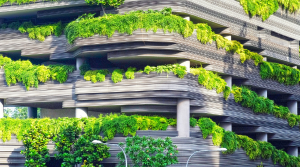
A third of people living and working in UK cities plan to leave in the next ten years, according to research from Landsec, with over half wanting to leave 'in the future'.
Landsec questioned 1200 people across some of the UK's major cities, including London, Birmingham, Manchester, Leeds, Glasgow, and Cardiff and the main reason was access to green space (34%), access to fresher air (33%) and to be closer to family and friends (24%).
The research is published at the same time as Landsec releases its nature strategy.
Expectations people have of what cities should provide for them has risen since the Covid-19. Over half (53%) of respondents now expect more to be done on issues including air quality, affordable housing, and greater access to nature near their homes.
Ninety-four per cent put at least some importance on nature access. Almost four in ten respondents (39%) named inclusion of green space and more trees, plants and wildlife as the biggest priority for developers in new building developments - only behind transport links (41%). over four-fifths (84%) believing their city should be doing more to prepare for climate change.
The nature strategy aims to deliver a range of nature-led benefits across its urban spaces, led by core principles which will apply across its current and future assets: improving biodiversity, promoting health, wellbeing, and community engagement and reating and maintaining high-quality green spaces that encourage social interactions immersed in nature.
Landsec will use the Environmental Benefits from Nature tool, created by Natural England and the University of Oxford, to evaluate the health, wellbeing, and community benefits it has created through improving nature across its developments. And the the Urban Greening Factor measurement to analyse the quality of green space on providing ecosystem services such as permeability, cooling, and air purification.
For existing assets, Landsec says it has committed an additional 10% increase to its existing BNG targets, while for future developments it will aim to make a 20% BNG on sites with existing 'greening' and ensure the development of 2 biodiversity units per hectare (2 unit/ha) for sites with 'no greening'.
The company has created 15 Core Nature Requirements (CNRs) that will underpin the development process, including guidance on which types of green interventions (GI) are required to satisfy each requirement. Guidance has been incorporated into Landsec’s Sustainable Development Toolkits, a comprehensive guide used by its development teams and external partners to ensure sustainability is considered throughout the design and construction of its projects.
It has also created Nature Action Plans (NAPs) for every operational asset under its control across the company. The NAPs were developed following a portfolio-wide ecological assessment, and lists opportunities for improvement on each site to deliver against the three core principles and metrics.
A Nature Handbook has also been developed to guide site teams and landscapers on design and implementation factors such as appropriate species and positioning.
Landsec will report on progress for operational assets every two years, while for future developments, progress will be updated on a project-by-project basis via ecological surveys to allow initiatives time to establish.
